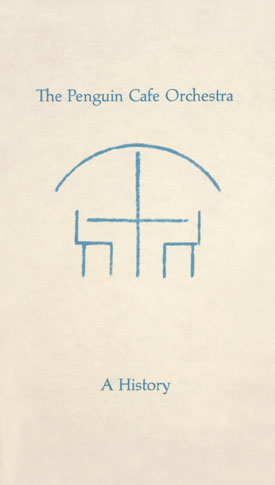 The Penguin Café Orchestra: A History is just that (although arguably it is as much a history of Simon Jeffes, but Jeffes and the Orchestra are so inextricably intertwined that I’m not prepared to argue the matter). The meat of the set is the four disc compendium and overview of the Orchestra’s music. Sandall’s essay gives some valuable context to the whole thing, and good insights into the — how shall I put it? — aesthetic context of the Orchestra.
The Penguin Café Orchestra: A History is just that (although arguably it is as much a history of Simon Jeffes, but Jeffes and the Orchestra are so inextricably intertwined that I’m not prepared to argue the matter). The meat of the set is the four disc compendium and overview of the Orchestra’s music. Sandall’s essay gives some valuable context to the whole thing, and good insights into the — how shall I put it? — aesthetic context of the Orchestra.
Jeffes’ own background is key here: feeling more or less like a displaced person — he spent part of his childhood in Canada before returning to England — he first encountered the guitar through a classmate at boarding school. He studied classical guitar and music theory at college, but felt it too confining, first joining a guitar ensemble, then working with producer Rupert Hine. Followed a trip across Siberia, winding up in Japan, where he discovered, of all things, African music (among other traditions). He wasn’t content, however, to be, as he put it, “a consumer of ethnic music” — he wanted to make it himself. What came out of this, ultimately, was The Penguin Café Orchestra, a somewhat mutable ensemble of musicians that incorporated a diverse and sometimes surprising array of instruments — spinet, ring modulator, ukelele, viola (and other strings), guitars (of course), and others that were, at the time, less familiar to Western ears.
The music itself is almost indescribable, which is perhaps not all that surprising. Listening through the four discs included in the set, it takes a bit before one is ready to accept the fact that all these songs were recorded by the same group (or nearly the same, give or take the changes in personnel). Influences are quite diverse, although one can pick out African rtythms in songs such as “Yodel 1” and a somewhat minimalist stance in “Cutting Branches for a Temporary Shelter,” which occupies a space somewhere between Philip Glass and children’s songs. (And it only just struck me how minimalist children’s songs really are.) One of the Orchestra’s most famous songs is “Telephone and Rubber Band,” which starts off with the sound of a telephone ringing (a British phone, somewhat more melodious than its American counterpart) and builds into a real cross-breed, with those repetitive minimalist rhythms segueing into something that sounds more than a little Afro-Caribbean. (And yes, there is a rubber band under all those layers of sound.) And of course, there is “Music for a Found Harmonium,” composed for a harmonium that Jeffes found in Japan. This one combines everything into one seamless piece that, to me at least, says “Penguin Café Orchestra.” (There are a couple of versions offered here.)
Penguin Café Orchestra’s music is generally classified as “New Age,” but one has to take that in the best sense: it’s rich, sometimes very challenging, incorporating diverse elements and traditions into what became a real synthesis. For some reason, I think of this music is somehow “English,” although I couldn’t begin to tell you why. Perhaps it’s just the sheer eccentricity of it all.
(Virgin Records, 2001)
